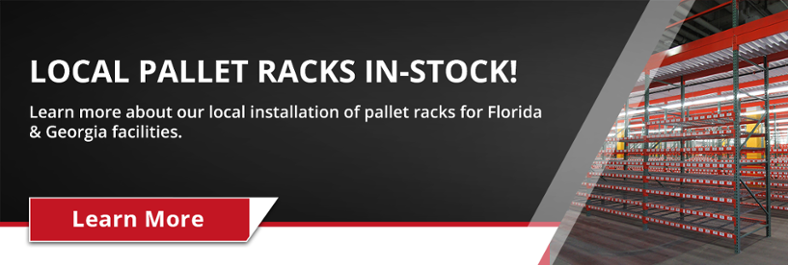Picking the right warehouse racking system for your specific needs can have a major impact on your ability to meet the productivity and efficiency goals for your warehouse. Broadly speaking, there are two primary types of racking systems to choose from: Roll-formed racking and structural racking.
To help you choose the right industrial shelving for your warehouse, here is a comparison of roll-formed and structural pallet racking.
Hot-Rolled or Cold-Rolled Pallet Racking
One of the fundamental differences between roll-formed and structural pallet racking system options is that roll-formed pallet racks are made of cold-rolled steel while structural pallet racking systems are made from hot-rolled steel.
Hot-rolled steel is, as the name implies, processed while the steel is red-hot (typically around 1,700˚F), which is above steel’s crystallization point. Because steel expands as it heats up, there may be some shrinkage as the steel cools—but hot steel is also easier to form in the first place.
Cold-rolled steel is shaped and processed at room temperature. This results in more consistent shapes and dimensions than hot-rolled steel since the metal is already cold and will not contract after being finished.
As noted by Reliance Foundry in an article about hot- and cold-rolled steels, “because hot rolled steel is allowed to cool at room temperature, it’s essentially normalized—meaning it’s free from internal stresses that can arise from quenching or work-hardening processes” and “hot rolled steel is ideal where dimensional tolerances aren’t as important as overall material strength.”
Comparing Racking System Weight Capacities
While the Reliance Foundry article notes that cold-rolled steel is typically stronger than hot-rolled steel, when it comes to warehouse racking systems, hot-rolled structural pallet racking typically has a much higher overall tensile strength and impact resistance than cold-rolled pallet racking. Why is this?
One reason is that structural racking systems are typically made from heavier, thicker steel than roll-formed racks. Additionally, roll-formed pallet racks use teardrop connections that are easy to assemble, but less secure than the bolt connections used by structural racking systems.
The result is that a roll-formed rack might be rated for 3,385-7,000 pounds of weight while some structural rack systems can handle in excess of 30,000 pounds of weight depending on the style of racking system used and the spacing of support beams in the racking. It should be noted that these numbers are broad generalizations—you should always contact the manufacturer for more detailed information regarding the specific weight capacity of a racking system before buying and installing it.
How the Two Types of Racking Systems Handle Impacts
Because of its additional rigidity and strength, structural racking tends to handle impacts better than roll-formed racking. This is important because of the risk of forklift impacts with racking systems that may occur when drivers misjudge the distance between their forklift and the rack.
However, for both types of racking systems, it’s important to take precautions to prevent forklifts from directly impacting the racking in the first place. Adding corner guards, warning signs, and floor markings can help forklift drivers avoid making direct impacts on racking systems with their forklifts—helping prolong the useful life of both types of warehouse racking.
Ease of Assembly
When it comes to ease of assembly, roll-formed racking beats structural warehouse racking systems hands down. Roll-formed racks use teardrop connections that don’t require any additional parts—just a mallet to smack the pieces firmly into place or to hammer safety clips on.
The bolt connections and heavier weight of structural racking systems make them a bit more difficult and time-consuming to assemble. However, the difference in initial setup is negligible enough to make this, at best, a secondary concern. What the ease of assembly really impacts is the flexibility of the racking system.
For example, say that you need to redesign your racking system layout for your warehouse. With a roll-formed racking system, the process of taking apart and reorganizing the racks, or even substituting different types of racks and rack accessories, is incredibly simple. Meanwhile adjusting beam levels on structured racks is a more difficult and time-consuming process.
Warehouse Racking System Costs
In terms of cost to purchase and ship, roll-formed racking systems are typically less costly than their structured counterparts. This is due, in part, to the fact that roll-formed racks are typically lighter than their structured counterparts, being made of lighter steel in the first place. Also, because they’re easier to install, the labor costs for installing roll-formed racking is usually slightly lower.
This means that roll-formed racking systems can provide a return on investment (ROI) for their costs a bit faster than structural racks. However, the heavier construction and useful life of structural racks may provide a greater return on investment over a longer period of time.
Which Warehouse Racking System is Best for Your Needs?
So, which of these two types of warehouse racking systems would be the best fit for your warehouse?
Structural warehouse racking might be a better fit for warehouses with:
- Largely stable inventories;
- Heavy pallets;
- Frequent forklift interaction;
- Large budgets for investing in longer-lasting racking systems; and
- A need for outdoor racking (since these racks are easy to galvanize).
Roll-formed warehouse racking might be ideal for warehouses that:
- See frequent changes to their warehouse design/layout;
- Stock mostly lightweight products/pallets;
- Have more frequent manual movement of objects than pallet-based forklift movement; and
- Need a less costly warehouse racking system because of budget constraints.
Need help choosing the right industrial shelving for your needs? Southern States Storage & Handling is here to help you find the perfect racking system for your warehouse—whether you’re looking for brand new or used warehouse racking systems. Contact us today to learn more.






